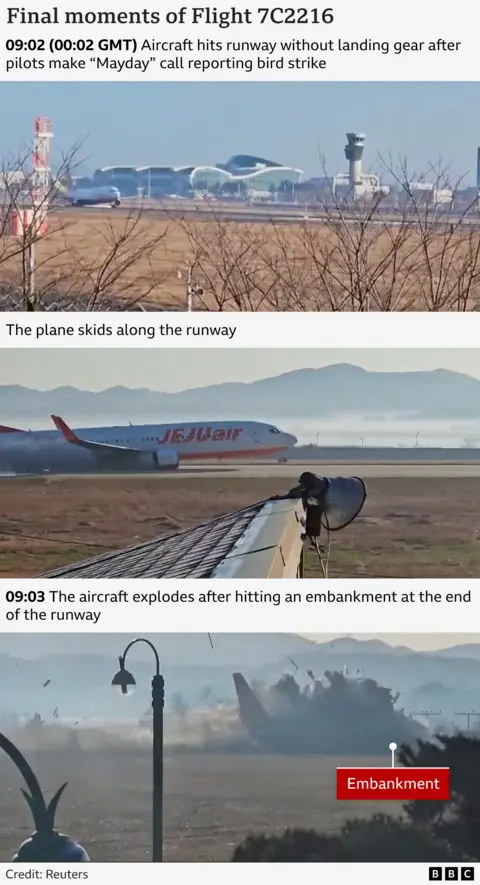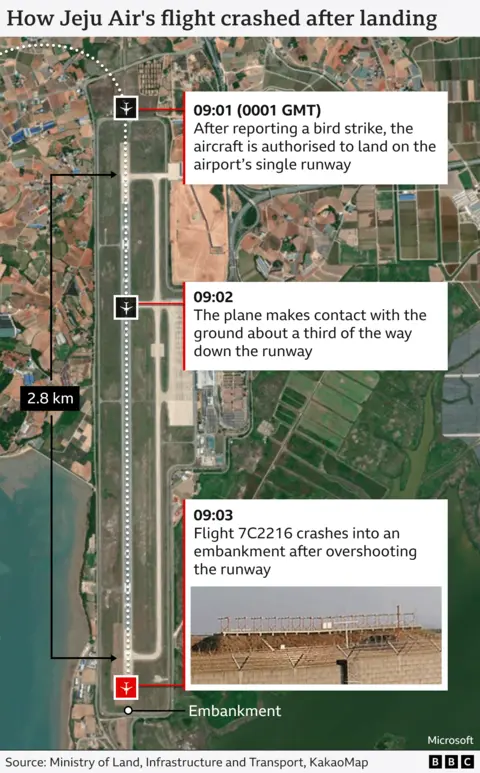Aviation consultants have raised questions on an “uncommon” concrete wall close to the runway and its function within the South Korea aircraft crash that killed 179 folks.
Footage exhibits the Jeju Air aircraft coming off the runway earlier than colliding with the wall and bursting into flames at Muan Worldwide Airport on Sunday.
Authorities investigating the reason for South Korea’s worst-ever aircraft crash are contemplating the importance of the concrete wall’s location about 250m (820ft) off the top of the runway.
Air security professional David Learmount stated that, had the “obstruction” not been there, the aircraft “would have come to relaxation with most – probably all – these on board nonetheless alive”.
The pilot reported that the aircraft had struck a hen after which aborted the unique touchdown and requested permission to land from the other way.
The aircraft got here down a ways alongside the two,800m runway and appeared to land with out utilizing its wheels or every other touchdown gear.
Mr Learmount stated the touchdown was “nearly as good as a flapless/gearless landing might be: wings degree, nostril not too excessive to keep away from breaking the tail” and the aircraft had not sustained substantial harm because it slid alongside the runway.
“The rationale so many individuals died was not the touchdown as such, however the truth that the plane collided with a really arduous obstruction simply past the runway finish,” he stated.

One other aviation analyst agreed. Captain Ross Aimer, chief govt of Aero Consulting Consultants, advised Reuters information company: “Sadly, that factor was the rationale that everyone obtained killed, as a result of they actually hit a concrete construction. It should not have been there.”
Christian Beckert, a Lufthansa pilot primarily based in Munich, referred to as the concrete construction “uncommon”, saying: “Usually, on an airport with a runway on the finish, you do not have a wall.”
The concrete construction holds a navigation system that assists plane landings – referred to as a localiser – in line with South Korea’s Yonhap Information Company.
At 4m excessive, it’s coated with filth and was raised to maintain the localiser degree with the runway to make sure it features correctly, Yonhap reported.
South Korea’s transport ministry has stated that different airports within the nation and a few abroad have the tools put in with concrete constructions. Nonetheless officers will study whether or not it ought to have been made with lighter supplies that will break extra simply upon affect.
Chris Kingswood, a pilot with 48 years’ expertise who has flown the identical kind of plane concerned within the crash, advised BBC Information: “Obstacles inside a sure vary and distance of the runway are required to be frangible, which implies that if an plane strikes them that they do break.
“It does appear uncommon that it is such a inflexible factor. The plane, from what I perceive, was travelling very quick, landed a great distance down the runway, so it’s going to have gone a protracted well beyond the top of the runway… so the place will you draw the road with that? That is actually one thing that will likely be investigated.
“Aeroplanes usually are not sturdy constructions – they’re, by design, mild to make them environment friendly in flight. They’re not likely designed to go high-speed on its stomach so any form of construction might trigger the fuselage to interrupt up after which be catastrophic.

“The gasoline is saved within the wings so as soon as the wing ruptures, then the potential for fireplace is critical.
“So it isn’t a provided that if the wall had not been there, it might have been a totally completely different end result.”
Mr Kingswood stated he can be “shocked if the airfield hadn’t met all the necessities in accordance with business requirements”.
“I believe if we went across the airfields at a number of main worldwide airports… we might discover a number of obstacles that might equally be accused of presenting a hazard,” he added.
Nonetheless former pilot John Cox, chief govt of Security Working Methods, stated the runway design “completely (did) not” meet business greatest practices, which preclude any arduous construction inside no less than 300m (984ft) of the top of the runway.
Following the crash, it emerged that remarks in Muan Worldwide Airport’s working guide, uploaded early in 2024, stated the concrete embankment was too near the top of the runway.
The doc, ready by Korea Airports Corp, beneficial the placement of the tools be reviewed throughout a deliberate enlargement.
South Korea’s director-general for airport coverage, Kim Hong-rak, stated the federal government would “overview the related rules and their utility”.
Aviation analyst Sally Gethin questioned whether or not the pilot knew the barrier was there, notably given the aircraft was approaching from the other way from the same old touchdown strategy.
She advised BBC Information: “We have to know, have been (the pilots) conscious there was this difficult boundary on the finish?
“In the event that they have been directed by the management tower to reverse using the runway the second time round, that ought to come out within the investigation of the black packing containers.
“I believe there are such a lot of questions.”

At a information convention on Tuesday, Jeju Air’s chief govt Kim Yi-bae wouldn’t be drawn when requested in regards to the concrete wall.
Requested by a reporter if he thought the wall was an element within the catastrophe, he didn’t give a direct reply and as a substitute stated it was proper to name the aircraft crash the Jeju Air catastrophe, fairly than the Muan Air catastrophe.













